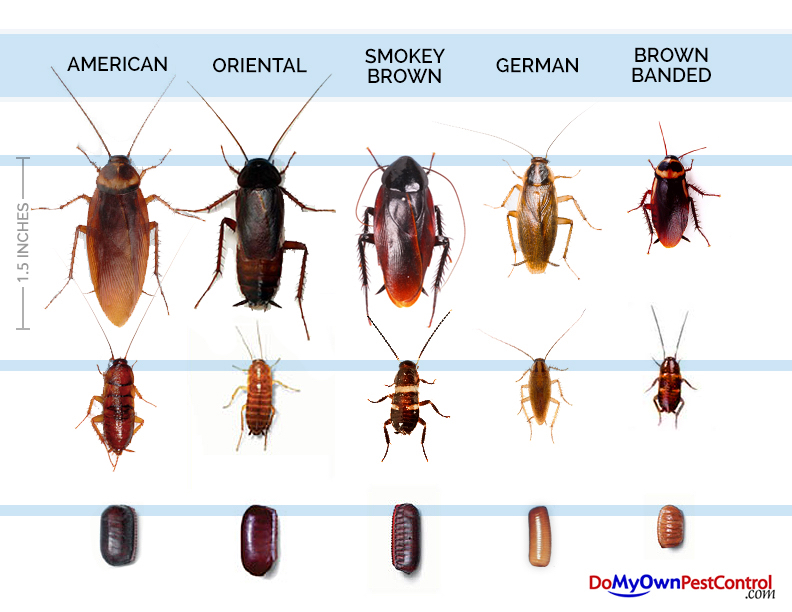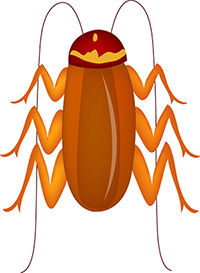Couldn’t You At Least Say Something Nice About Me? – Cockroaches
By Bill Willis (WAIT) and John McLamb (SEPB)
November 29, 2016
It happens all the time, whether owners are present or not, night or day, in any neighborhood. Yes, the threat of a home or office invasion exists. People cringe at the thought of anything getting into their personal space uninvited with the intention of doing them harm or causing destruction.
Do any of these unsavory characters look familiar?

Depending on the species, newly hatched roaches can vary from 2mm-5mm in length. The immature young may shed (molt) up to thirteen times before becoming adults. As adult roaches, they can vary in size from about .25 inch to 2 inches. Knowing the different markings and sizes of the roach during each stage of its life can help in the identification.

Where did the roaches come from?
All these guys are immigrants having arrived on cargo ships or in products from Tropical Africa, South America, Europe, and the Far East. Human activities continue to spread more of them around the world.
Which roaches are considered pests in North Carolina?
Most of the 70 species in America prefer staying outside as feral roaches in the woods “where the wild things are”, benefitting from the life cycles there. Roaches are not strict vegetarians, but will feast on a wide variety of organisms and materials. However, a few species, like those in the line-up above, quickly adapt to “human” home life and can become real pests.
- The German cockroach (Blattella germanica) also goes by the names: d*** bug, roach, or Croton bug. This roach is tan to dark brown with two dark stripes on their pronotum (shield-like covering the head). Although it’s wings don’t support flight, getting inside is no problem for humans provide the means. This species avoids light and runs when lights are turned on. It will breed indoors and does so quite efficiently. What it lacks in ½” size, it makes up in reproductive prowess, capable of producing a million individuals over the course of one year. It prefers wet, humid conditions as found in kitchens and bathroom. These guys produce an “aggregation” scent which smells bad to non-roaches.
- The Smoky Brown cockroach (Periplaneta fuliginosa) also goes by the name: roach or smoky. This uniformly shiny brown roach is second only to the German cockroach in abundance, but closer in size to the American roach. Outside, it resides in woodpiles, feasting on plant matter and bird droppings. It can be seen in cool garages and outbuildings.
- The American cockroach (Periplaneta americana) also goes by the names: cockroach, roach, palmetto bug, or d*** bug and is the only roach that qualifies as an American “frequent flier”. Its coloration is dark reddish brown with a cream-colored pronotum that has dark markings that resemble sunglasses. It has the distinction of being the fastest running insect. It will be drawn to porch and streetlights, although doesn’t require a night-light. American cockroaches prefer damp conditions and are often found in sewers, woodpiles, mulch, and debris. This roach can breed indoors in basements, kitchens and bathrooms.
- The Oriental cockroach (Blatta orientalis) also goes by the name: waterbug or black beetle. This shiny black roach prefers to live in hollow trees and stumps, but is at home in basements, cellars, and crawl spaces where it’s cool and damp. About the size of the American roach, it feeds upon garbage and decaying matter.
- The Brown-Banded cockroach (Supella longipalpa) also goes by the name: little brownie. It has a dark tan to light brown overall body color, and can be identified by two light-colored bands across the wings and abdomen. It is strictly nocturnal and has the distinction of being able to jump. It prefers high starch foods like potato and rice items.
Why do roaches enter buildings?
Given unfavorable circumstances (cold, drought, predators), they’ll come for a visit. They’re not overly choosey and might be indicative of a failed “Good Housekeeping Seal of Approval” certificate. You could leave a light on, but it’s not necessary for them to find you, plus you’d probably scare them. Even the best of families could have a few in their closet. Roaches need what all creatures need for survival: shelter, food, and water plus a little love. Most human homes provide these ingredients.
How do roaches enter buildings?
A crack or crevice, duct, drain or sewer pipe is a possible path inside. Humans can carry them inside in bags or boxes, and other packages. Or they can come inside through open doors.
Do roaches pose any health concerns?
Roaches and flies have a reputation of being dirty and unsanitary. Both seek out and crawl through cracks, crevices, and unclean places. Roach’s dead skin (molt), feces, and saliva proteins can trigger or augment house allergies and asthma. With a life expectancy of one year, a lot of protein can accumulate and sensitize young children. Oriental cockroaches can be a source for many food-borne pathogens, including E.coli, Salmonella spp., and other pathogens.
Do roaches have predators?
Cockroaches have many natural predators, including man, toads, frogs, beetles, geckos and iguanas. Don’t put too much faith in the geckos and iguanas, for they are easily distracted and wander off. Humans on the other hand are highly excitable and could panic before causing too much harm.
Which roaches have been seen on campus?
Recent sightings have been reported in common spaces and offices. Fall and winter occurrences in laboratories, hallways, and break areas are common. Usually a single individual is observed when lights are first turned on, especially where food is present. Compost bins, recycling containers, and trash cans with discarded food items attract them.
What measures will be taken?
According to John McLamb, our Integrated Pest Management Coordinator, our initial response would be a mechanical or physical approach. Cracks are sealed and door sweeps are replaced to help prevent the insects from entering the building. The widespread use of sprays or liquid insecticides is not generally sanctioned because of possible effects on research and the concern for allergic reactions. Bait stations and glue traps, placed in areas where the roaches may frequent, are possibilities.
What can you do to help?
- Place food into a closable container or refrigerator.
- Sweep up crumbs and spills immediately.
- Clean under and behind appliances.
- Reduce clutter that might provide hiding places.
- Plug or close off potential entry points.
- Remember that a single roach sighting is not an infestation.
- Roaches may be miss-lead and end up where they really don’t want to be.
- Report any significant insect activity.
- Preventing frequent encounters is an ongoing process.
References:



